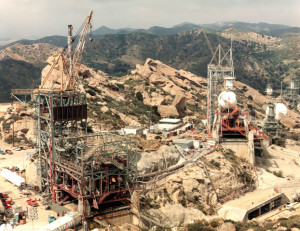 Rocketdyne cleanup agreements leave out adjacent canyon slated for development
Rocketdyne cleanup agreements leave out adjacent canyon slated for development
By Michael Collins
Ventura County Reporter – December 9, 2010
The Dec. 6 news of the agreements between California’s Department of Toxic Substances Control (DTSC) and both the federal Department of Energy (DOE) and NASA set off a wave of euphoria rarely experienced in the long saga of the Santa Susana Field Laboratory (SSFL).
The agreements call for DOE and NASA to clean up to “background” the polluted soil on their parts of the 2,850-acre lab that sits in the Simi Hills on the eastern edge of Ventura County. Remediating to background, or normally occurring, levels of radiation and chemicals will obviate the need for expensive and time-consuming risk analysis of the hundreds of toxins at the site and keep the lab on track for full cleanup by 2017.
“This historic agreement is great news for nearby residents in Ventura County and the people of California,” said Gov. Arnold Schwarzenegger. “I applaud all parties for their commitment to working on a solution that will clean up the environment and protect the health of residents in the bordering communities.”
That is, all bordering communities except the new one of 461 homes and condominiums that developer KB Home has been trying to build in the southern Simi Valley in a place called Runkle Canyon. That canyon has tested high in radioactive strontium-90 and toxic heavy metals, including arsenic, nickel and vanadium.
Runkle Canyon is not included in the new state-federal agreements even though levels found in a developer’s 1999 report on environmental conditions in the canyon revealed strontium-90 levels averaging 27 times normal.
Strontium-90 causes leukemia along with other blood and bone cancers.
First exposed as possibly contaminated by the Reporter more than five years ago (See feature “Which Way the Wind Blows,” March 17, 2005), an estimated 112 tons of dust impacted by strontium-90 would be sent aloft by construction.
The huge development has since been stalled by the revelations and by a Simi Valley group of citizen activists called the Radiation Rangers, which formed in 2006 in reaction to the news. The group has led calls for comprehensive testing of the canyon that the community can trust isn’t rigged by the developer.
Runkle Canyon is downhill from SSFL, which was the site of 10 experimental nuclear reactors, a “hot lab” for cutting apart spent reactor fuel rods, and rocket test stands that conducted more than 30,000 ignitions for decades, leaving the former Rocketdyne lab heavily polluted with radiation, chemicals, heavy metals, PCBs and dioxins.
In 1959, the worst partial meltdown in the nation’s history occurred at Rocketdyne, releasing, by some estimates, hundreds of times more radiation than the better-known meltdown at Three Mile Island in Pennsylvania in 1979.
The new agreement to clean up the lab to its normal state has delighted many of the residents, including Holly Huff of the Rocketdyne Cleanup Coalition, which formed in 1989 to oppose then-lab owner Rockwell in efforts to renew its nuclear testing license.
“This has been a long time coming. For over two decades we have been waiting for this day to come,” Huff said in a statement released by the coalition. “Now we can put the past behind us and work together with the Department of Energy and NASA for a clean Santa Susana Field Laboratory, which will only benefit the future generations here in our communities.”
Huff, however, is distressed that Runkle Canyon’s situation will not be remediated, even though 2007 testing of its creek by the Radiation Rangers that showed the creek’s arsenic readings were 15 times the “maximum contaminant level” for drinking water, more than 21,000 times the EPA’s “preliminary remediation goal” and 37,500 times the agency’s “public health goal” for potable water.
At a Dec. 7 DTSC meeting in Chatsworth, the department addressed the strontium-90 dilemma, finally coming to a conclusion of “No evidence or pattern of onsite release, or release from SSFL,” negating three developer reports showing high radiation in Runkle Canyon.
“I have a very simple solution,” said Radiation Ranger the Rev. John Southwick at the meeting. “Leave Runkle Canyon alone for 100 years and then go back and look at it.”
24 Years of Award-Winning SSFL/Rocketdyne Reporting
June 1998 – June 2022












Recent Comments